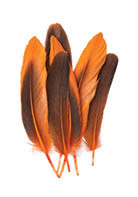Return to 4th Quarter 2023 articles.


Feathers are made of the protein keratin and are connected to blood vessels, similar to how our hair is connected to our vascular system. Once a feather reaches its final stage, it disconnects from the blood vessel that has nourished it, thus reducing its weight. When molting occurs, and old feathers are discarded, tiny muscles reconnect the vascular system to grow a new one.

Feathers serve the bird by providing insulation, waterproofing, color, display, and flight in remarkable ways. Peacocks can present colorful displays, but so can parrots, pheasants, and various tropical birds.
Feathers provide insulation by trapping air, which is a poor conductor of heat. Down feathers trap air efficiently while adding very little weight to the bird. This same feature gives waterfowl their buoyancy as well as insulation. Birds preen their feathers, treating them with oil from a gland just above the bird's tail. The tight interlocking barbules in a bird's outer feathers make them impenetrable to water. Birds use down feathers to produce an environment that allows eggs to hatch and to keep chicks safe.
Flight is possible because each wing feather has the shape of an airfoil to provide lift and minimize drag. Since the feathers are flexible, they can move to reduce drag, and their tips are designed to minimize turbulence, making smooth flight possible. They really are complex structures of ingenuity.
Color in bird feathers is accomplished in several ways. For some feathers, melanin gives color to the feather's keratin, and the bird’s diet can control its color. A flamingo's pink color comes from eating algae that contain carotenoids. Rather than using pigments, many brightly-colored bird feathers use structural color produced by manipulating light waves to create blues, greens, and iridescent colors.
Considering the complex structures we know as bird feathers brings to mind Psalm 9:1, “I will praise you, Lord, with all my heart; I will show forth all your marvelous works.” Feathers are among those marvelous works.
Picture credits:
© New Africa/Bigstock.com
